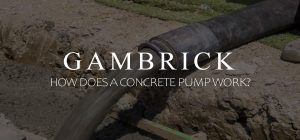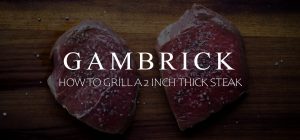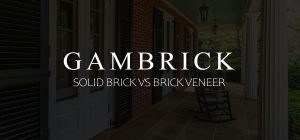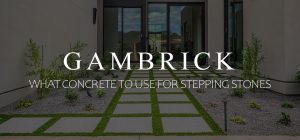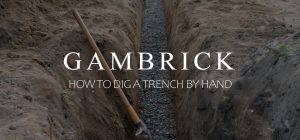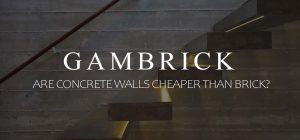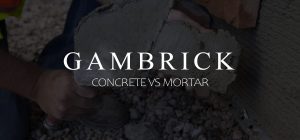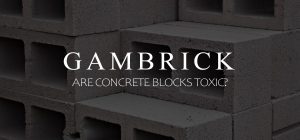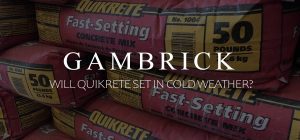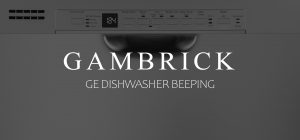
What Are Concrete Forms?
Concrete forms are a solid structure that holds wet concrete in place. When the wet concrete dries, it assumes the shape of the form it was poured into. Think of forms as a mold for concrete. They can be made into just about any shape and are used in a variety of applications. Solid concrete foundations are built with concrete, rebar and forms. The forms are built, rebar installed and concrete is poured. Later you remove the forms and the result is a foundation. This same basic method is used to build patios, sidewalks, footings, walls and even large projects like pillars, bridges and damns. Even finish products like cast fireplace surrounds, furniture, planters and countertops are built using concrete and forms.
I’ve been a mason for over 25 years and use forms on a daily basis. Just about everything I build out of poured concrete uses a form. In fact, even a simply trench or hole dug for a footing essentially functions as a form, holding the concrete in place as it hardens.
Many newer forming systems do other things as well, such as providing insulation. These systems are call Insulated Concrete Forms or ICF. We use these advanced forms to build some of the most energy efficient homes in the world.
Basic forms on the other hand can be as simple as 2x4s nailed together to form the outer edges of a sidewalk or patio
Concrete is a unique building product because it starts out as a semi-solid. It’s then poured into forms and allowed to harden into any shape. This ability to fill voids and assume shapes is what makes concrete one of the most widely used and versatile building materials in the world.
Concrete Forms Have A Long History
The history of concrete forms, also known as falsework or formwork, dates back to the Romans who used concrete and cement to build roads and structures. For as long as people have used concrete, there have been forms to shape and mold it into place.
Forms come in a variety of materials such as wood, metal, plastic, other masonry products like stone or brick, and foam insulation panels. The purpose of forms is to hold the semi-solid cement in place until it hardens. Some forms like wood are removed once the cement hardens, while others like brick, stone, or insulation remains.
Forms are like different shaped molds. They hold wet concrete in place until it hardens and assumes the desired shape.
There are six major types of concrete forms that can be used to hold and mold concrete in place while it sets and cures.
- Wood Forms. Traditional timber forms are the most basic and widely used. They can be as simple as a few 2x4s nailed together to form a sidewalk or pad.
- Engineered Forms. These are made in a factory out of a variety of materials.
- Re-usable Plastic Forms.
- Permanent Insulated Form. Panels made from rigid foam.
- Stay in Place Structural Forms. These are typically left in place after the concrete is poured.
- Flexible Forms. Used to create unusual shapes for unique structures.
Concrete Forms Are Very Strong
A square foot of standard 3500 – 5000 psi concrete weighs about 150 pounds. A homes foundation can require thousands pounds wroth of concrete. All that weight has to be held back by strong concrete forms, which is why most forms are made from reinforced wood or metal.
In recent years, there have seen some advancements in concrete forms made of plastic, fiber glass, resins, and other composite materials, but overall, the cost and strength of these materials hasn’t replaced the performance of metal and wood.
Concrete forms are often categorized by where and how they’re used. The best form for the job is the one that can handle the pour size, amount of concrete, the shape, and the weight that will be pushing against the form.
The most common concrete form used for flat work, like a patio, driveway, sidewalk or road, is made from wood. Because the forms are very low and the majority of the weight of the concrete is spread across the ground, they don’t need to be as strong as foundation forms.
A concrete form used to construct a bridge pier or building foundation will hold back thousands of pounds worth of concrete. These forms are generally much higher which means more pressure is being applied to the side walls. Because of the massive amount of weight being pushed against the walls, these forms are typically steel or engineered with strong supports. Wood is sometimes used but additional supports will be needed and thicker wood.
When concrete forms are removed, you may see some small surface level cracks. These aren’t structural, but they should still be filled with a basic crack filler to prevent water from penetrating and freezing.
If you see large cracks form after the forms are removed, you need fresh concrete or epoxy.
The Six Major Types Of Concrete Forms
Concrete forms come in six major types. Below we’ll look at them in depth.
Wood aka Timber Forms
Wood forms have been used to mold concrete for centuries. It’s the oldest known material for molding concrete into all sorts of shapes and brick. These days, the most common type of wood used to make a form is plywood. Although any type of wood can work as a form.
To build walls or footings, wood panels are secured to wood or metal supports which form walls. The forms should be level, in the exact position you want the finished concrete and secure before pouring any concrete. Plywood can be used to form any final shape which includes a radius.
Wooden forms are some of the most flexible kind and can create just about and shape. They can even be used in conjunction with other types of forms. For example some times we’ll use insulated forms for part of a basement that has living space and wood forms for non insulated storage areas.
Wood forms can be used to build smaller things like patios and walkways. The most common type of form used in construction is probably a 2×4. Nail them together to form the sides of a sidewalk patio or walkway.
Concrete steps can easily be formed by nailing together a series of 2x6s or 2x8s.
Generally wood forms are removed after the concrete hardens. It isn’t necessary for the concrete to fully cure. 7-10 hours after you pour is generally enough. If you want to trowel finish the sides of your concrete then remove the forms sooner while the concrete is still workable.
Wood forms can be reused as many times as you like as long as the wood doesn’t get damaged during the pour or removal. A releasing agent is a good idea if you plan on reusing the forms.
Scrap Wood Forms Are Cheap
Making forms out of scrap wood is one of the cheapest ways to mold concrete. In the building business, there’s almost always scrap wood laying around a job site. Instead of throwing away all that scrap, pick out the long pieces and build forms.
Traditionally, wood has been a relatively cheap material to build forms out of. But these days wood has become a very expensive material to work with so masons are using other materials.I recommend getting the most bang for your buck by using scrap if you can.
Engineered Forms
Wood can warp, buckle, crack, deform and shrink if your not careful. A lot of additional reinforcement is needed as the structure becomes larger. The weight and outward pressure inside a form can add up fast as you pour more concrete. To counter all that pressure you’ll need more and stronger supports holding the forms because the plywood itself can only hold so much.
For large scale concrete pours you may need a stronger material than plywood. Consider steel, aluminum, or other types of engineered materials. Because the engineered form itself is stronger, you don’t need as many supports. Most residential foundations are built using engineered forms instead of timber.
Engineered forms are generally more expensive than using traditional timber but they cost less to install since you don’t need as many supports. If you factor in the labor savings the cost is comparable to wood and often times better.
Using an engineered form can save you time and money in the long run. For example, the time it takes setting up and breaking down an engineered form is much faster when compared with wood. If you use forms a lot it’s definitely worth the extra money.
Under proper maintenance, your engineered forms are re-usable. I recommend using a releasing agent when possible.
Engineered Forms Are Safer
Engineered forms tend to be safer to use. There are safety features built into the design and better ways to connect them to one another which cuts down on accidents and breaks.
It’s not uncommon for a plywood form to buckle under the pressure which ruins the pour. Engineered forms are much stronger so this isn’t as big an issue. And they use less supports which is one less thing that can fail.
Engineered Concrete Forms Aren’t As Versatile
Wood can easily be shaped into just about any form you want. Even radius work isn’t that hard when working with wood because thin plywood is flexible. However engineered forms are delivered made in the shape you order. You don’t build them on site like with wood so there’s little customization. If you don’t have the engineered form for the shape you need, then you’ll have to use wood for that section.
The good news is that you can use engineered and wood forms together. Many masons will use the engineered forms for the long sections and right angles with wood for radius work.
When choosing between using wood or engineered forms, consider the size, scope, design and shape of the project. You would tend to use the engineered form for larger projects and wooden forms for smaller custom projects.
Re-usable Plastic Forms
Re-usable plastic forms are great for building concrete columns, pillars, countertops, furniture, fireplace surrounds and other cast products.
Most of the time, these forms are modular, which means that they can be configured into different shapes for a variety of applications.
Most forms are made from a strong plastic called ABS or acrylonitrile butadiene styrene. The strength of the plastic is beneficial when building large structures. The plastic is lightweight, powerful, and easy to manage on-site.
We rarely use plastic forms on construction sites to form a foundation. Although there are applications where they come in handy.
You can reuse plastic forms as long as you care for them properly. Most plastics also made out of a material that doesn’t stick to concrete which is another benefit of using plastic. All you have to do is clean the form with water when it’s removed. Although I still recommend using a little release spray.
Permanent Insulated Forms
Permanent insulated forms are assembled on site and remain in place after the concrete has hardened. These systems generally contain insulation to support the concrete while it’s being cast. They are commonly known as ICF.
ICF is a very cost-effective way to construct a structure because it saves time and money by forming and insulating at the same time. The foam form is fire-retardant and can also add to the acoustical features of the building.
Some of the most energy efficient building in the world are using ICF in their design. A solid concrete wall with ICF can create an air tight barrier with almost no thermal bridging.
ICF is typically held together by supports and an internal plastic rebar system that clips in place. Foam panels are fastened together and stacked like Lego blocks. When complete the foam forms are very strong and able to hold an extreme amount of concrete.
Foam panels and blocks can be custom cut and formed to almost any shape. A standard hand saw is more than enough to cut the foam. No power tools are needed.
Concrete is poured into the top of the forms just like any other type of form. The only real difference between ICF vs. wood, engineered or plastic is that the forms remain when the job’s completed.
Stay-in-Place Structural Forms
This type of form speaks for itself. These are forms designed and built out of a variety of materials that stay in place after the pour is complete. They act just like an insulated concrete form, ICF, only they’re not insulated.
ICF is a type of stay in place structural form.
Here is a list of the different types of materials used for this form:
- Polyvinyl chloride (PVC)
- Fiber-reinforced polymer (FRP)
- Galvanized coiled sheet
- Fabricated steel
- Carbon/Epoxy thin shell
Flexible Forms
Unlike all the other types of concrete forms we’ve discussed, flexible forms use tough sheets of fabric that have high tensile strength. They can be formed into all sorts of shapes and forms.
Flexible forms can be used for projects where you want to create something interesting or more fluid. Unique architecture that can’t be poured into rigid forms can use a flexible form. Using this form saves you time with projects that require complex structures.
Sometimes refereed to on job sites as a flex form.
These types of forms are almost always used on commercial project. I’ve never seen a flex form used on a residential home. Although I’m sure there are some exceptions somewhere in the world.
Sonotubes
Although a sonotube isn’t typically thought of as a concrete form, that’s exactly what they are. You can buy them in just about any Home Depot or Lowes in a variety of sizes.
Sonotubes are round forms that are filled with concrete to build footings and piers. Their made from paper, which means after the concrete hardens anything above ground can be peeled away and discarded. What’s below ground is biodegradable and safe to remain underground.
Tips
Before pouring concrete into a wooden form, you can coat the wood with a low-grade oil or releasing agent so the concrete doesn’t stick to the wood. Think of a cake pan lined with cooking spray.
When pouring concrete into a tall form, like a foundation form, make sure to use a vibrator. You can buy a vibrator attachment for just about any screw gun. Vibrating the concrete eliminates voids and air bubbles that will weaken the wall.
Thin forms like what we use to build a concrete countertop should be banged with medium force and shaken. The purpose is to shake the concrete which helps it settle. This eliminates voids and air bubbles just like a vibrator.
If you want to smooth out the sides of the concrete after the forms are removed then don’t wait until the concrete is fully hardened. Remove the forms a little early so the concrete is strong but still workable. Use a little water as you work the concrete to make smoothing it a little easier.
If you remove the forms fast enough it’s possible to throw on color that’ll stick. This is done in the same way as a stamped concrete patio. It’s also early enough to gauge or scratch shapes and forms in the concrete. This is one of the ways theme parks make their large scale attractions like Disney Land. Concrete is shaped and colored before it completely cures.
Summary: What Are Concrete Forms?
Concrete forms are a solid structure that holds wet concrete in place. When the wet concrete dries, it assumes the shape of the form it was poured into. Think of forms as a sort of mold for concrete. They can be made into just about any shape and are used in a variety of applications. Solid concrete foundations are built with concrete, rebar and forms. The forms are built, rebar installed and concrete is poured. Later you remove the forms and the result is a foundation. This same basic method is used to build patios, sidewalks, footings, walls and even large projects like pillars, bridges and damns.
Even finish products like cast fireplace surrounds, furniture, planters and countertops are built using concrete and forms.
Many newer forming systems do other things as well, such as providing insulation. These systems are call Insulated Concrete Forms or ICF.
We use these advanced forms to build some of the most energy efficient homes in the world. Basic forms on the other hand can be as simple as 2x4s nailed together to form the outer edges of a sidewalk. Or a few pieces of wood nailed together to form a brick mold.
Concrete is a unique building product because it starts out as a semi-solid. It can be manipulated and worked in its liquid form to assume almost any shape. It eventually hardens to assume the shape mold or form it was poured into.
This ability to fill voids and assume shapes is what makes concrete one of the most widely used and versatile building materials in the world. None of this would be possible without concrete forms.
If you have any questions email or leave a comment below.

John Mazzuca | About | More Posts |
Custom Home Builder
John Mazzuca is a custom home designer and builder at Gambrick with over 25 years experience in the construction industry. John has designed, built and/or remodeled hundreds of homes, small buildings, and commercial projects. He writes about business, real estate, home building, and household electronics. His work has been featured in Fox Business, Better Homes & Garden, House Beautiful, and more.

